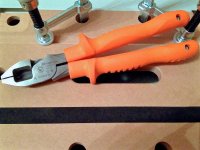S
six-point socket
Guest
Hi,
WARNING WARNING WARNING WARNING
My statement is NOT TRUE the jaw is NOT NON CONDUCTIVE...
WARNING WARNING WARNING WARNING
so here's another small review of a tool from my stable, Snap-On's C59AHLP non-conductive Lineman's pliers, 10".
Let me start by saying this is a very special tool that caught my interest because it combined the strength and cutting abilities of standard steel pliers with the non conductivity otherwise only found in plastic pliers. So this is not your common insulating pliers, but entirely non-conductive pliers made from Snap-On's so called "composite material".
[attachimg=1]
The first thing you probably notice is that these pliers are pretty large, feature a wide head and large cutting area. Which is pretty awesome when working with large diameter cables, especially those for outdoor use, with their thick rubber sheathing and/or large diameter solid wire cables. Additionally the front portion of the jaws are checkered in a very coarse manner to provide a very strong grip. Please not that the jaws will not close completely, this is not a fault but by design. In the rear you'll find another checkered area either for cable pulling or crushing.
What I like best about these pliers is their 2-position grip. It allows the user to either use them commonly or at an additional length far behind the head at the widest point of the handle - this is great when pulling something that requires a lot of force.
Most certainly this tool is not for everyone, but if you need to work on live wires/cables or machines and parts thereof where electric current might be or is present, especially if we're talking 230V and up, the non-conductiv composite Lineman's pliers are well worth the investment.
Kind regards,
Oliver
WARNING WARNING WARNING WARNING
My statement is NOT TRUE the jaw is NOT NON CONDUCTIVE...
WARNING WARNING WARNING WARNING
so here's another small review of a tool from my stable, Snap-On's C59AHLP non-conductive Lineman's pliers, 10".
Let me start by saying this is a very special tool that caught my interest because it combined the strength and cutting abilities of standard steel pliers with the non conductivity otherwise only found in plastic pliers. So this is not your common insulating pliers, but entirely non-conductive pliers made from Snap-On's so called "composite material".
[attachimg=1]
The first thing you probably notice is that these pliers are pretty large, feature a wide head and large cutting area. Which is pretty awesome when working with large diameter cables, especially those for outdoor use, with their thick rubber sheathing and/or large diameter solid wire cables. Additionally the front portion of the jaws are checkered in a very coarse manner to provide a very strong grip. Please not that the jaws will not close completely, this is not a fault but by design. In the rear you'll find another checkered area either for cable pulling or crushing.
What I like best about these pliers is their 2-position grip. It allows the user to either use them commonly or at an additional length far behind the head at the widest point of the handle - this is great when pulling something that requires a lot of force.
Most certainly this tool is not for everyone, but if you need to work on live wires/cables or machines and parts thereof where electric current might be or is present, especially if we're talking 230V and up, the non-conductiv composite Lineman's pliers are well worth the investment.
Kind regards,
Oliver


